Barzam A.B. Automation in Electrical Power Systems (Системная автоматика)
Подождите немного. Документ загружается.


fntrance
I
tAtEtc0
Intrance
2
2A2B2C
C
Fig'
11-6.
Schematic
diagram
of ATS
deiice r'ith
the
use oI
control
statjon
AUTOIIATIC TRANSFER
TO RESERVE
SUPPLY AND
EQUIPMENT
343
reset
time has elapsed,
the
relay
lATR
makes
the closing
circuit
of
the contac-
tor
of
Entrance
2.
AJter
the
contaetor
2L
has
closed., the
auxiliary contact
2L-BC-1
makes
and closes
the
rela-v
2ATR which
opens
the
coil
circuit
for
closiug
the contactor
.2.L.
Not'
Entrante
g
performs
tbe
function of the
main suppiy
and
Entrante
7
is
used
as
the stand-by
suppl.y
source
The
time taken to close
the
stand-b5'
supply
by means
of the relay
CfR is
0.5 s in order to
prevent
the
application
of
the stand-by
supply voltage
to tb.e
coasting
excited srmchronous
and'asyn.chronous
motors.
If no
delay is reguired
in
the operation
of the ATS device, the
jumpers
(bridges)
2J
ar.d
4-I must be
removed.
A
simplified contactor
circuit for ATS
operations is
shown
in Fig. LL-7.
Contactor KI of. the main
suppi-v
entrance is normally
closed.
When
the entran-
ce is deenergized the
contactor drops
out and closes its
auxili&r5r
csrtrrct which
closes
the
circuit of the contactor
K2
rhaL
switches
on
the
stand-bv
sunnh' ent-
rance. The instant,aneon*s
ATS ac.t.ion is det,ermined
by the
tripping,ii*e
ot
contaci,or
K-Z and
the closing
time
of
contactor
K2.
The
ATS device is isolated
by closing knife switch
J.
t1-5.
Self-Starting
of
an Aqmchronous
Load
Interruptions
f.o
the
normal
power
suopi5'
uccur riu:ing
faults
in
the
porp-el
suppil'
circuit and
wben
the
ARC and
ATS devices
operate.
Short
time
(0.72
to 0.15
s)
interruptions hardiy
brake the
asynchronous
load
and most of the
motors
do
not lose
synchronism.
That
is s'hy,
q'here
high-speed
protection
units
and breakers
are used, tbe
short
circuits have
but Iitt,ie effect
upon the ioads
and
causeno self-unloading
of
the power
svstem.
With inter-
ruptions
of
seconds
and more,
n'hich
occur
*'hen
the
ARC
(except
HSARC) and
ATS
devices-operate,
the
as5'nchronous
motors
may
decelerate
and even stop,
and
the synchronous
motors
must
be
transferred to
asynchronous
starting
n-i[h
subsequent
reslachronization
otherwi-se
thel'
]s5. their slnelrronism
and must
be
disconnected.
Because of the
above reasons
the
supply
lines
generallS.
carr-T
a
current in
excess
of the
normal
value
after voitage
reestablishment.
Stand-
From
entrdnce
i *a'r;1
,
Load
11-7.
Circuit
of
ATS
device
emplol,ing
contactors
If
there
is
a
possibility
of the
aslnchronous
load
self-starting (synchronous
motors transferred
to the
aslnchronous starting
mode are
also
as,vnchronous
loads), the
proteotive
relaying
calculations
must
take
into
account
an
increase
in
the
currents.
This
phenomenon
is evaluated by
a starting
factor
K,
whose
value
depends
on
the
composition
of the load
and
whether
the
motors are fur-
nished s'ith
a
protector
that
deenergizes the
motors
when
the
voltage drops.
Voltage
protection
must be installed
on
less
important
equipment-which
is
disconnected
in
order
to
faciiitate the
starting
of the
motors
driving important
the value
of
.I(
wrlrg.
from
1.5 to
3
and
ma
be
ro
determined n the
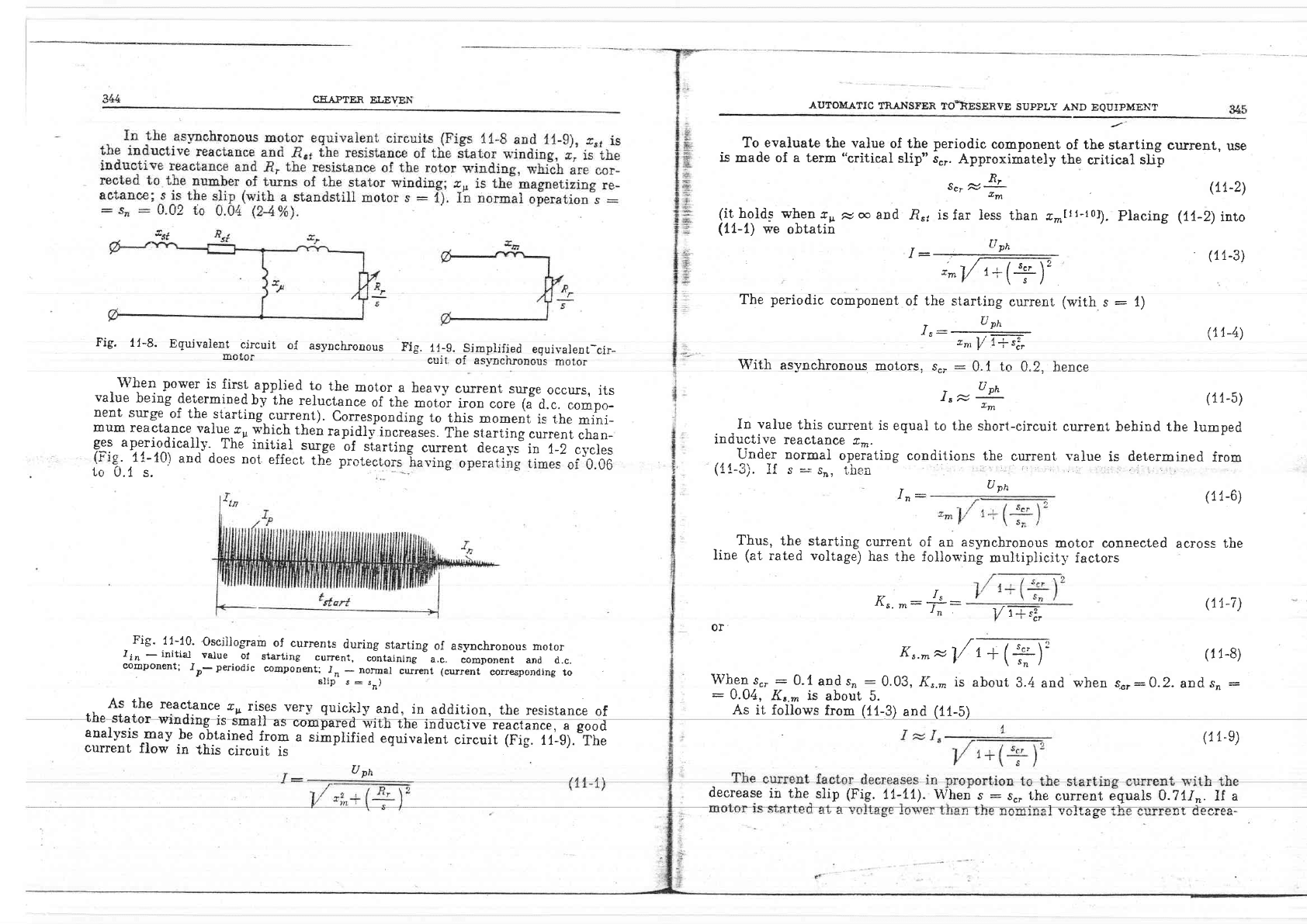
CEAPTE.R
ELEYEN
AUTOMATIC
TRANSFER
TO*KESENVE
SUPPLY
AND
EQUIPMENT
To
evaluate
the value
of the
periodic
component
of the
J*rur**
currenr,
use
is
made of
a term
"critical
slip" s"r.
Approximately
the
critical slip
5", XL
'&m
(it
holds when
rv
N
m
and
.R"1 is
far less than
e-tl1-101).
Placing
(1,1-1)
we
obtatin
t:&
: t / ,
,
/
$cr
\z
**y
'-\
,
I
The
periodic
component
of the starting
current
(with
s
:
1)
I
,
-
--JPh--
znrl/
!-s!,
\4lith
asynchronous
motors,
sc,-
:
0.1
1o
0.?,
hence
(1,\-2)
(11-2)
into
(11_3)
(11-4)
Fig'
t1-8-
Equivaient
circuit
of
asynchronous
Fig.
11-g. Simplified
equivalentlir-
motoi
cuit
of
asynchronous
motor
]lttf^f-ryy:]:ll"*,"pqlied
to
the
moror.a
heavv
currenr
surse
occurs,
its
::::."*::s^_d'.1.^'-^l:..qLt-1h-ereJ3cF"J;irh';;#il;;;,;T;.;";;l;;:
nent
surge
of the
starting.gu.rre-nt).
Correspo"dirg
il;hil;;;;rii
i. iir."#iij-
mum
reactance
value,cu
y!i:\
then
rapidlli
ioc.ea"ses.
The
,i"rtin[
current
chan_
ry;
age.riodicaii-v-
The
inirial
surge
of
si,arting
current
d;;a.is-
ii
t-z
"y.t*.
IItg;,t1^-tOt
and does
not
effect
th-e
pro*,ectori
-having
operating
times
of 0.06
-
Uon
t"xt
(11-5)
In
value
this
cunent
is
equal to the
short-circuit
current
behind the lumped
inductive
reactance
c-.
Under normal
operating conditions
the
current
value
is determined
from
(it-3).
II s
-
s,,,
tben
r-
tn-
(1
1-6)
across
the
(11-7)
(1
1-8)
to
0.1
s.
upn
Thus,
the
starting
Iine
(at
rated voltage)
current
of an
as-\'nchronous
motor connected
has
the follorn'ing
multiplicitv
factors
Kr.
^:
*:
V
t++
r--
K,.^*l/
r
+
(+)'
Fig'
11-10.
oscjliogram
of
currents
during
starting
of asynchronous
motor
-l;r.
-
initial
value
ot
starting
current,
containing
a.c.
component
and
d.c.
coEponent;
JO-
periodic
componenlr,rJ.r
;ji5al
current (current
corresponding
to
As
the
reactance
cn
rises
verl,
quickiy
and,
in
addition,
the
resistance
of
the
stator
winding
is
ima}I
us
"om$"rea
witnJhe
inductive'reactance,
a good
analvsislnav
be
obtained
from
a
simpiifi.d
"di;*teoi.i.""il-frif.
rr-s;.'iir.
current
flow
in
this
circuit
is
or.
\47hen
s".
:
0.04,
As it
:
$.1and
s,,
:0.03,
Kr.-
is
about
3.4
and
when
{cr:0.2.
and
sn
:
Kr.- is
about
5.
follows
from
(11-3)
and
(11-5)
(11-e)
\4/hen
s
:
s.. the
current
equals
A.77Ir.
If. a
uph
decrease
in the
slip
(Fig.
11,41).
rTnltofo
'
v^eq6v
nT
atoa?ao-
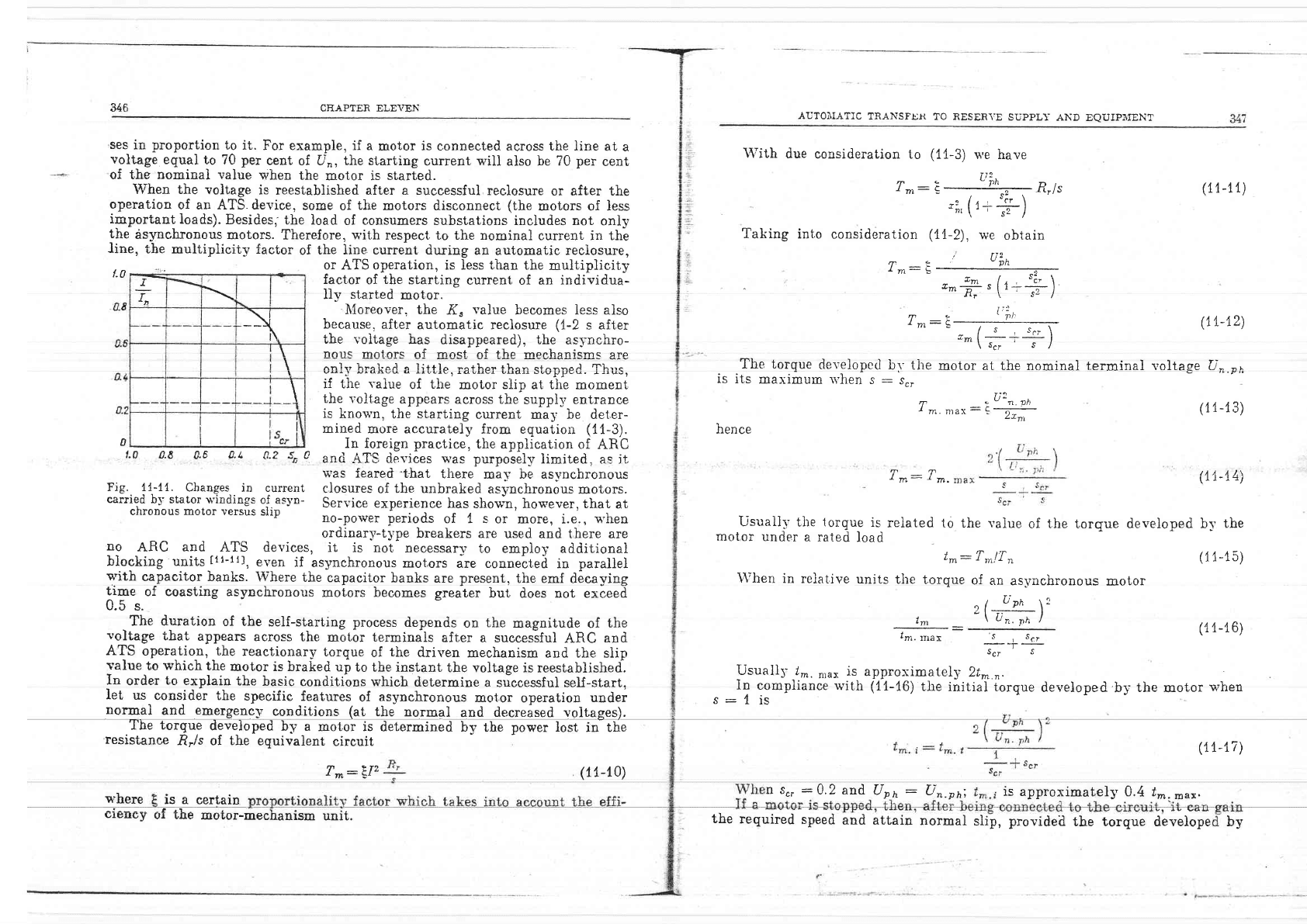
346
CHAPTER ELE\EIi
ses
in
proportion
to
it.
For example, if
a
motor
is
connected across the line
at
a
voltage
equal
to 70 per
cent
ol Un,
the starting
current
will
also
be 70
per
cent
oi the
nominal value
wheu
the
motor is
started.
\\rhen the
voltage
is
reestablished after a successful
reclosure
or after the
operation
of an ATS. device,
some
of
the
motors disconnect
(the
motors of }ess
important
ioads).
Besides;
the load
of
consumers
substations
includes
not
oniy
the
asynchronous
motors.
Therefore, with
respect to the nominal
current in the
line,
the multiplicity
factor
of
the ]ine current
during an
automatic reclosure,
or ATS operation,
is less
than
the
multiplicity
factor
of
the
starting
current of
an individua-
I1;r
start,ed
motor.
h{oreover. the
J(,
va}ue
becomes less a}so
because.
aft,er
automatic reclosure
(1-2
s after
the voitage
has
disappeared), the
asynchro-
rrous
mot,ors
of
most
of the
mecbanisms
are
nnl.t hrol.o.l o li++lo --fLar *1r-- o*^-*nJ
rn},".
vur
l
qAUu
u
Il(,llE,
lqUtIsMAlr LTVUIJ}JSU.
lllUD,
if tiie
value
of
tiie
motor slin at tire momeni
the volt,age
appears across
the-supplJz entrance
is
known.
the starting
current ma5' be det,er-
mined
more accurately
from equation
(11-3).
In foreign practice.
the
application
of ARC
and
ATS
devices
was purposely
limited.
as it
was
feared
'that
there
mav be asvnchronous
T
-?'r2
4m-br
u'here
is a
certain
AUTotrIATIC
TRAliSprjR TO RESERYE
SUppL-f
AND
EQUIPIIEI\:T
f-0
\Vith
due
consideration
to
(11-3)
u'e have
Trr:;
--Q
nrl,
"i,,(l-+)
I
Taking
into
consideration
(II-2),
we
obtain
T -!
u'un
-rtL
=T
,*+r(1=+)
.ftr\s"/
1i: ,
Tnr:E
, ,
n"
- =
I
s
,
s.rJ
"-
(
,-
--;i
The torgue
developed
br- the
motor at the nominaj
is
its
maximum n'hen
s
:
scr
ri2
T
o..
n,"t:il-!-eh-
'*n1
hence
(1-t1)
(11-r2)
terminal voltage Un.pn
(r1-13)
(tr-M)
T
_T
^
m-'m.
UsualIl'
the
lorque
is
related
motor
under
a
rated
load
NA
t.0
n9
U.t
n, < n
Fig..
!1.-11.
Changes.
in current
closures
of
the unbraked
asj,ps6t.rous
motors.
"""ti*d-,Lljg"l.l::d^:19:
:f,:t)'o-
Service
experience
has
shovl, however, that
at
cnronous moror
versus
sllp
tro-power
periods
of { s
or more, i.e.,
u'hen
no
ARC and
Arq
devices,
"t',*t"r:'IlTt:J;::Ifi:
il',H'ff:u"hH;i"ili
biocking units-[11-11],
even
if
asynchronous
motors
are conneit,ed
in
paralle]
s'ith
capacitor banks.
Where
the
capacitor
banks
are
present.
the emf
decaying
tige
of coasting asynchronous
molors becomes
greater
but
does
not
exieed
0.5
s.
The duration
of the
self-starting
process
depends
on
the
magnitude of
the
voltage
that
appears
across
the
mol.or terminais
after
a succesiful
ARC
and
ATS
operqtio_n,
-the
reactionarl'
torque
of
the
driyen
mechanism
and the slip
value
to
which
the
motor is braked
up
to the instant
the voltage
is reestablished.
In
order
to
explain
the
ba-sic
conditibns which
determine
a
successful self-start,
let
us
consider the
specific
features
of
asynchronous
motor
operation
under
nornal
and
emergerc-lr
conditions
(at
the normql
and
decreised voltages).
The torgue
developed
by a
motor is
determined
by the
power lost
iilthe
resistance
,Rrls
of
the
equivalent
circuit
to
the
vaiue
of
the
torgue
developed b5'
the
t*:
T.,nf
T,, (11-i5)
\\'hen
in
relat.ive
units
the torgue
of
an
as\rnchronous
motor
^t
uph
1!
t"''
'\T:;
)
lrr,.
rrrax
..
+
,a'.
scr s
Usually
/-.
n,r,
is
approximatelS,
2t^.,
In
compliance
u'itli
(11-16)
the
initial t,orque
developed
by
the
motor
when
s:1is
(1r-16)
(11-17)
I sc.
:0.2
and
Urn
:
Un.pni
is approximately
0,4 r*.
-"o'
E
0
r--
T
-tl
_\
\
\
t
\
l
cieney
of the
moior-mechanism
unit,.
(11-10)
the
required
speed
and attain
normal
slip, provided
the torque develope by

CI1APTER
E.LE\EN
AUTOMATIC
TRANSFER
TO
RESERVE
SUPPLY
AND
EQUIPMSNT
349
motors and
reactionary
torques
are
shown
in
Fie.
11-12.
So
that
an as,vnchronous
motor
can
gain
speed
and drive
a
mechanism
rp-ith
a
constant
reactionarv
torque"
it has a
squirrel-cage
rotor
(a
deep
bar double-u'ound
rotor)
and a
charac-
teristic
at v,'irich
fn, is
greater
than l,.
whate-
ver
the
slip
ma1'
be
(curve
4 in
Fig. 1.1,-t2).
TS ^ *^+^- L^^ ^ -L^ J --e-- -- I rL-
rr
d
l.u.LrLUl rras
a
prrasr-r,yuttuu
roLUI'
auu
Lll.t}
reactionar_v
torque
has
a
characi.eristic
depen-
dent
on
the
slip
(curve
2), then
the
mbtor
generall,l'
can gain
speed. for
in starting
the
terminal
voltage
of
the
motor
is enough
to
develop
a torque
in excess
of the
reactionar-v
torque.
As can
be seeu
frcm
(tt-16),
the torque
developed
bg the
motor is
directl_r- proporiro-
nal
t,o
the
sguare
of
the voltage
across the
stator
terminals.
In
order
to
ascertain
t,he fact
::t^t:t-e:t"^lT"k:
the
calculations
more
complicated
withour
any
positive
influ-
ence
on the
answer.
In the
case
of the
self-starting
of
all the
receiving
substation
asynchronous
motors
their
reactances
are
calculat'e.{
in csmrl-iance.*ith
(r1-5).
ii
tn-
-"i}lpU"rli
tT.#i
,} *" p""i"'Ji"
component
of the
starting
currint
is
knovn,
then
- s
Un-ph
An.ph
--iif-:-
f=-:-F-
,'
sx
rts.
m/2.
!
where
/no is
tbe total
norninal
current'of
ail
the
as5rnchro[olLc
motors.
If
only
a
feu'of
the
asynchronous
motors (e)
are
setrf-started,
the
reactance
of
these
7
xrn,
gs:- sm
s
(1
1-f8)
(11-19)
(11-20)
Tbe
totai
sLarting
cun -
nt
is
t-
-
6. SS-
Un.
oh
t-)-r,J-+.-J-+
-5
I
-'
|
*t
|
*rTt.
IXi
pQn'er
s!'steno.,
Iine,
and
transformers.
resDect_
pplication
and
tbe
stator
*,inding
terminals
of
ninals
which
provide,s
the
self-starting
can
be
re
initial
torgue
is aboui
b0
per
cent"
ol
t[;
r
normal
vo}[age.
sr,
s,
o
An.
ph
zml
pJh
:
fs.
sscm.
ss:
(t1-21)
(11-22)
(11-23)
whether
a
important
motor
is
capable
of self-starting
after
reclosing
across
the
line,
it
is
to know
the
value
of this rloltage
across
Lhe
motor terminals,
(rr*"r
+"ri+#
0.3
-
":=
+0.7
(z.f
rlf
z1)
a:0.43
,'^t
zr1'r-T{,
c1
d
%:43
','^',
s,st:Dtiet
Tests
cariied
,out
by
sopg
organizations
show that
self-starting
of asr.nchro-
:.tYi.::l"j:_.",t-!ale
nlace
at
motor
terminal
voltages
even
less thin
Z0
f"t
"*"t
rJr
Llrv
ilulIIlIIaI
value.
lrence
or
Fig.
11-13.
Calculation
diagram
(o)
circuit
diagram;
(b)
eguivalent
circuit
AJter
an interruption
in-the
supply,
the
first
to
self-start
must
be the
motors
of
the
most
importaut
mechanisms.
So
that
v/e
may-calcuiate
the
value
of the
asynchronous
load
which
may
re-
main
connected
and
determine
the
value
of the
Lsl,nchronous
ioad
r*-hich
must
be disconnected
by
the
undervoltage
protection
or"other
ng
oI the
nost important
motors,
we
assume that
the
braked
e rong
tlme
perrods
to
attain
reguired
speed
and
heav5r
volta
drops
lmes)
neve
reactatrces
in the
equivalent
circuit
(Fig.
Il-lg).
To
incjude the
(which,
in
rurn,
mayipoil
the produ;ri;;;il;;;i
and
curre"t
o".itJi'j;'#;t
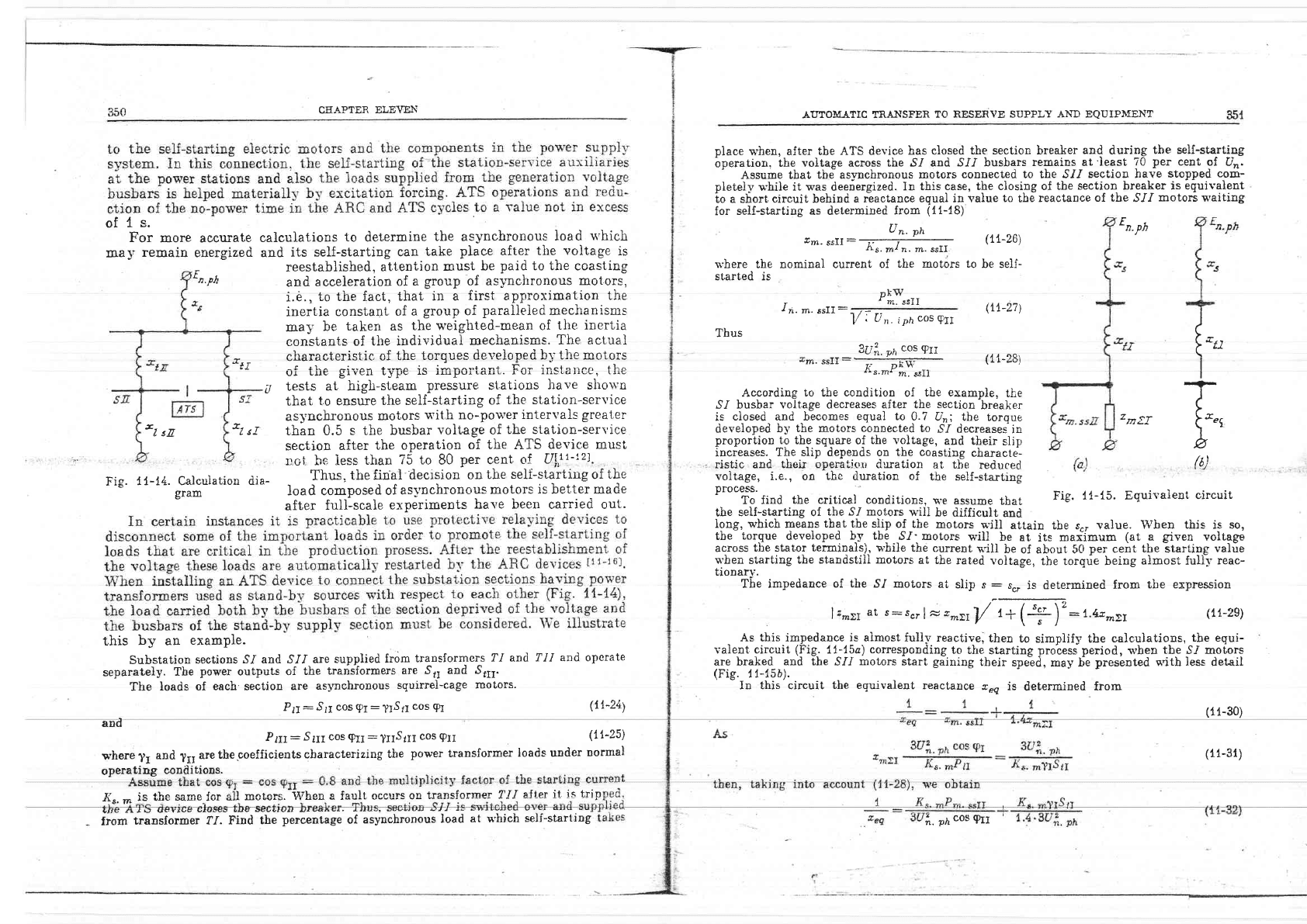
CE.{PTER
ELEVEN
of1s.
For
more accurate
calculations
to
determine
the asynchronous
load
tvhicir
ATTTOM.A.IIC TR.ANSFER
TO RESENVE SUPPLY
AND
EQUIPMENT
plaee
r*'hen,
after tbe
ATS device
has closed
the section breaker
and
during
the self-starting
bperation.
the voltage across
the S.l and .9f.I
busbars
remains at'Ieast
70
per
cent
of
L'r.
'
Assume tbat
tbe aslrnchronous
motors
connected to the S.I.I
section have
stopped
com-
pletely
r*'hile
it s'as
deeiergized.
in this
case, the closirg of
the section breaker
is irquivalent
i,o a sf,ortcircuit
bebind
a riactance
egual invalue
to
tbdreactance
of the ^S.I.I
motoriv'aiting
for
self-starting as determined
from
(11-18)
Un.
ph
*m'
ssrr
-
Kr.
*]
n. rn. ssrl.
rthere
the nominal current
of
the motors to
be seII-
started is
r.
t
n. m. asll
*
pxW
'
m. ssII
(Lt-27)
V
:
U
".
inrr
cos
gII
zmtT
Er-Ph
I
t_
t
*r,
I
-T-
I
\'*
B
(o)
(rL-26)
ma))-
remain
energized
Ir'Ph
xtr
and
its
self-starting
can
take
place after
the voltage
is
reestablished,
attention
must
be
paid
to the
ccasting
and
acceleration
of
a
group of asynchronous motors,
i.e.,
to the fact,
tirat
in a
first approxination
the
inertia
constant
of
a
group
of
paralleied
mechanisms
may
be
taken as
the
v'eighted-mean
of
the
inertia
constants
of
tire individual
mechanisms.
The
aclual
^h.rontorictin nf f hc f nv'nrroe dpr:alnnpd hrt t lrp rnntnrs
wuqrqvuvt
roLrv
vr
-f +'I.^ -:--^- +---.^;-;*nnr,{nn* F^- i-c*-'.^^ {L^
ul
LIlc
Hr
Yerr LyPt,
rD rrI-IPUr
L(rlrL. I ur
rrrE-tqrrus-r
(rrE
U
tests
at high-steam
pressure
st.ations
Jrave shorvn
that
to ensure
the self-starting
of
the station-service
as-vnchronous
motors
with no-po$rer
interval-c
greater
-l
,E
zl
tr
Fig.
t1-14. Calcuiation
dia-
gram
and
P
fi:.911
cos
9f
:
?tSrl
cos
EI
Prrr: Si11
cos
9tr:
?rrSttl
cos
P11
than 0.5
s the busbar
voltage
of
the station-serlice
section
after
the operation
of the ATS
devic.e must
noi be less
than
75 to
80
per
cent
of
Ullt-t2}.
Thus.
the linal-decision
on
the
seli-startiug
of
tbe
ioad composed
of
as-vnchronous
motors
is better made
after
fuli-scale
experiments
hale been canied out.
Tbus
IUi-,.
pn
cos
P11
,1, ^o\
rrn.
sslr
&;FF
('rl-zor
According to the
condition
of
the example,
the
^S.I busbar
voltage
decreases
after the
section'breaker
is
closed and becomes
egual Lo
0.7
[in; tbe
torque
developed
b1'
the motors
connected
to
,91
decreases-in
proportion
to
the square of
the voltage,
and tbeir
slip
increases.
The slip depends on
the coasting
characte-
ristic and
their operatlr'ri
ciuration
at the
reduced
voitage, i.e., on
thc
duration
of
the self-starting
process.
-
To find
the critical conditions,
s.e assume
that
the
seU-starting of
the S,r motors
will
be difficult
and
Iong, n'hich means
that the slip
of the
motors
rrill
attain
tbe s.,
value.
lVben this is so,
the
torque
developed
by
tbe
.S.I'motors
q'ill
be
at
its
max-imum
(at
a
given
voitage
across
tile stator
terminals),
u'hile tbe
current
s'ill
be
of
about
50
per
cent
the
itarting
valie
rrhen
starting
the standstill motors
at tbe
rat,ed
voltage,
the torqrie being
aimost
full1,
reac-
tionarv.
The impedance
of the S/
motors
ai
slip s
:
scf
is determined
from
ti:e expression
le.r,
at
s:scr
l="^Er/
,u(+)':t.k*r,
Fig.
11-15. Eguivaient
circuit
(11-29)
(11-30)
(11-3r)
this
b-v
an
example.
Substation
sections
S.I and
.9.If are supplied
lrom
transformcrs
?,I and ?.1.I
and operate
separately.
The
pos€r
outputs
of
the
trarisiormers
are
.S' and Sr1r.
The
loads of
each section
are
as1'nchronous
squirrel*cage
motors'
As this
impedance
is almost
fuIly reactive,
then
to simplify the
calcuiations,
tbe egui-
valent circuit
1Fig.
tt-tSa)
corresponding
to
thd
startine
pioi"ss peiiod,
v,hen
tbe
51 moiors
are
braked
and
the ,9.I/
r:notors
Start
giining
their
spe"ed,
may be
presented
with
less
detail
(Fig.
rt-15b).
In this circuit
the eguivalent
reactance
reg
is
deterrnined
from
$1-241
(rt-2s)
v-here?1
and
?ll
arethecoefficientscharacterizing
the
power
transformer
loads
under
norma)
operatiug
conilitions.
X, i - +!.n .. *^ {^.
AS.
m
^o luE
D4lre-Jvr
IXThon
p
forrlf
^r.trrc nn tr*ncfnrrncr TII aft.er ii.
is
trin
llrE
4ru us,vlvv
vrv!-vo
Irom
translormer
?.I. Find
the
percentage
of
asynchronous
load
at
q'hich
self*starting
[.
o;
cos
tPrr
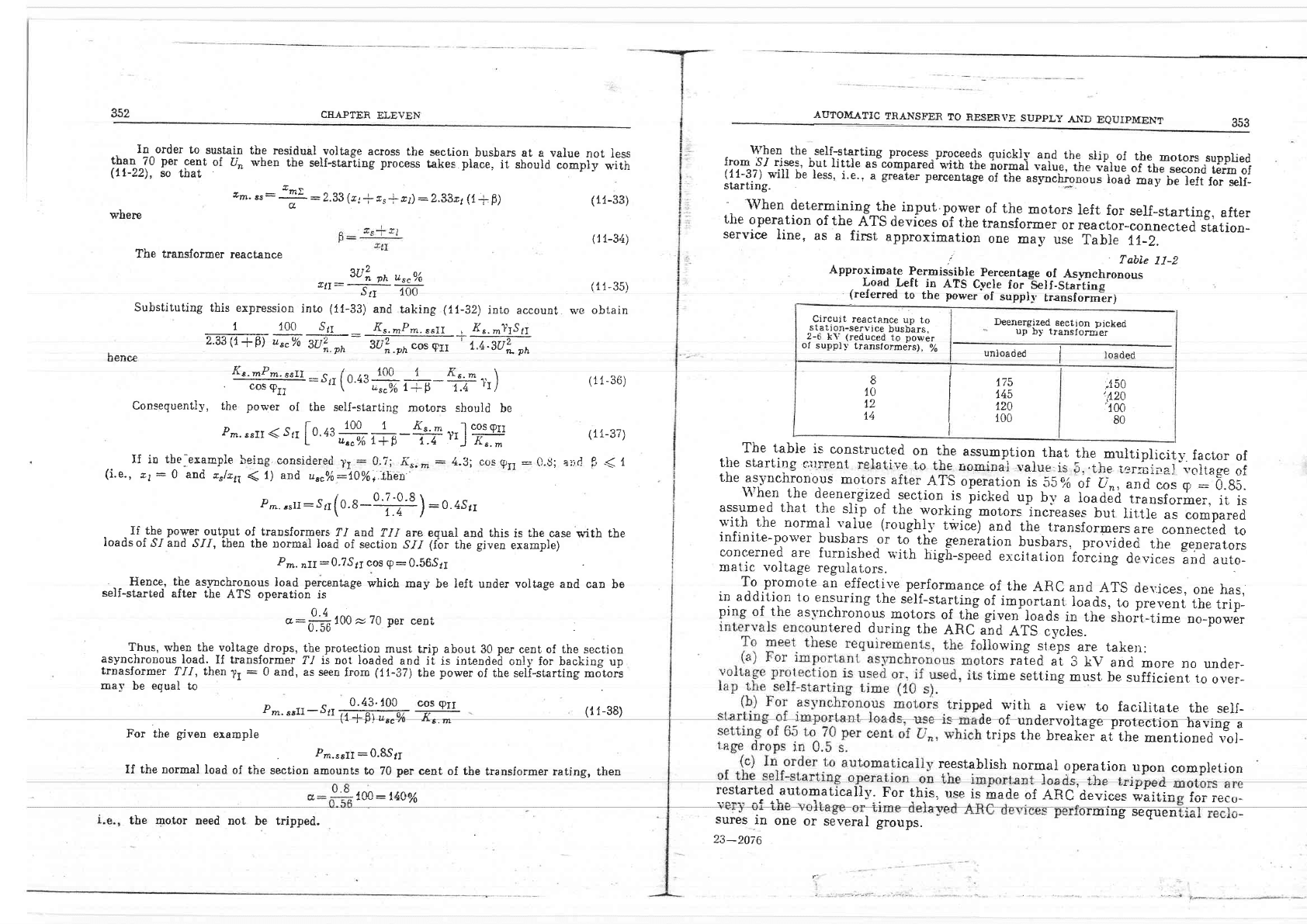
352
In
order
to
sustain
the residual
voltage
across
the
section
busbars
at
a value
not iess
l|lfjo
pet
cent
of
U,, when
the
self-star"ting process
t fri
pt""q-ii1["ria';;;pi;-;irh
(17-22j,
so
that
4m.
ss:'Tt
:
2.33
(r1i
rs*xt)
-
Z.z}zs(l
+p)
a
\4'hen
the
self-starting
process.proceeds
quickly
and
tbe
siip.
of
the
motors
supplied
from
.s/
rises,
but little
aJcompared'witu
iul
irorm;i
-=l;.,li"
lir,i,i
#inil"""ond
rerm
of
[i"t;lJr]-:tti
be less,
i'e.,
a
greater
percentage
"f
;h";sd;#";;";l;;;?"1,"6;i;;ii*
*ri-
-
\47hen
determining-the
input
power
of the
motors
left
for
self-starting,
after
the
oper-ation
of
the
ATS devices
of the
transformir
or reactor-connected
station-
service
line,
as a
first
approximation
oo,
-"5,
use
Table
t!_z.
i
Table
II_2
A.
pprox
i
rn a
te Permissibl
e_
Fercel
ta
ge
o f
As5,n
chronous
Load
Left
in
ATS
Cycle
for.-S.tt_St"itl"g
----
ATITOMATIC
TRANSFER
TO
RESERVE
SUPPLY
AND
EQUIPMENT
(referred
ro
the
power'of
s"ppti-ir"ir"..ro"i?.t
Circuit
reactance
up
lo
station-servi
ce
busbars,
2-d
k\'
(reduced
to
power
of
suppl-v
transformdrs),
o/o
Deenergized
section pickeri
up
.b}' transforsrer
-
unioade<i
I
loaded
8117b
,{50
'.
A t(\
:100
80
10lrus
t2
|
tzo
14
|
too
Tl:_:,:b]r^-:_::5lly"r*d
on
.rhe
assumprion
thar
the
multiplicit_v
r,ruL'Le.u
{rrr
Lre
assumptron
tnat
the
multiplicitv
factor
of
starting
c.itrrent
retratil-e
to
the
no,ninai,value
is
b,,the
ter.iln-ui"r'.oitrse
af
ouqrvrrJg
!'t{!rui-lL
i's!aLrYe
Lo
[-ce
noI]lnai,l'alUe
lS
b,,the
terruina-l
vOitagg
cf
asynchronous
morors
aft,er
ATS
operation
is
55
0r,o
of [.in,
and
cos
,
:
cr.sil
a-\Jr-rL/r.ru'uus
r_LruL0r's
arr,er
/\rD
operatlon
ts
JDy6
0I Ll
n,
and
cos
cp
:0.95.
\\rhen
the
deenergized
secrion
is
picked
up
by
;
I;"eJe
J;;;i;;er.
ir
is
assumed
that
the
"t-rTiri,'."ii'""'ir[J'fi?:,:i":L:JJXl1tt,tr-1t"J='?."-*"1'""1;
it.tle
as
compared
l:tr.h..rir.
norma]
r'alue
(roughl;'
twi;)
and the-iransform*r."",
;;;;#';;
CHAPTER
ELEVE}i
353
where
The transforrner
reactance
(r1-33)
(t
1-34)
(1
1-35)
n'e
obtain
(11-36)
(IL-37)
arC
3
--(
I
3U2n
on
u."/'o
"ri:_E_ffi
substituting
this expression
into
(1i-33)
and
taking
(ir-Bz)
inro account
jOL
Su
_
{*.
mP*.
sslr
,
Xs.
'TISTJ
z.aa (r
*
F)
u""
%
JUT;
-
-4
",
"*
fi,
=
t .aaq;
hence
Ks.mPm.ssrl-g
1^ro
100
I fi".--.
\
cosqrr
--"tr\u'{r--:-iTF-
r.<
rl/
Consequently,
the power
oI
the self-_ctarting
motors
should
be
Pm.
ssrr
--(
srr
[0.
ne
4:
-{P+
"r
l
"9,s
qrr
-
--L
-u""oioL*fi
I-4
,,)
K".^
If
in
the-exanple
heing
considered
?1
:
0.?;
X",-
:
4.3; cos g'
:
Cl.S;
(i.e.,
e;
:
0 and
c"/211 (
1)
and
ueco/o:i0%;.Lhen'
the
the
p^.,,u
:
s,1
(o.s-H€)
-
o. 4.s11
-
If the
power
output
of transformers
?1 and
TII are
esual and
this is the case
with the
loads
of ,S1
and .9.I.I,
tben
the lormal
ioad
of section
S^r/
(fbr
the
given
example)
Pm.
nIl:0'7Stt
cos q-0.56511
,,
Hence., the
asynchronous
ioad
percentage
which
may
be left
under
voltage and
can
be
self-started
after
the
ATS
operation
is
a'4
o:d* 100 =
70
per
cenr
.
Thus,
when
the
voltage
drops, the
protection
must
trip about
30
per
cent of the
section
asynchronous
load._
If transformer
I/
is
not
loaded
and ii
is intendeil
only for
backing up
trnasformer
TII, then
1,
:
0 and, as seen
lrom
(11-37)
the
power
cf the seli-starting
mdtois
ma-v
be egual to
h F
0.43.10C
cos
grl
Pp.ssrr-ru
GF)f;".%-
d
infinite-power
busbars
or
to-
the geneiation
busbars,
provided
tire
generators
concerned
are furnished
with
higli-speed
excitatioo
'fottiog-an"i".r
and
auto-
mat ic voltage
regulators.
---
---b
T"-
promote
an
effective
performance
of the
ARC
and
ATS
derices.
one
has,
in
addition
to
ensuring
the
s-elf-startilg
o{ imporiant
i""ar,
t"
p..r,*"t
the
trip-
ping
of the
asYnchronous
motors
oll4 given'loads
in
the.trorlt-iime
no-power
untered
during
the
ARC
ana
aTS
cycies.
llowing
step-s
are.
taken:
Lors
rated
at
3
kV
and
more
no
under_
rtime
setting
must
be
sufficient
to
over_
rd
witir
a
view
to
facilitate
the
self_
le
of undervoitage
protection
having
a
trips
the
breaker
at the
mentioned
iol_
(1
1-38)
For the
given
erample
'
P^'"stI
:0'8Stt
If the
normal
load
of the
section amounts
to
70
por
cent
oI the
transformer rating,
then
be
reestablish
normai
operation
upon
completion
:..^r_Tr_t:q f-"tom.a
tica
il
r,.
.
Fo r rhis,
use
i.
I
"
a.
of
eF.C'a.:ri
#
;;i;;
t^_ -^ -
rUI
I'EUU-
sures
in
one
or
several
groups.
orrnrng
sequen
tbe motor
need not
tripped.
0.8
4r\A - r r.n^r
tw
-
t=v70
23-2076
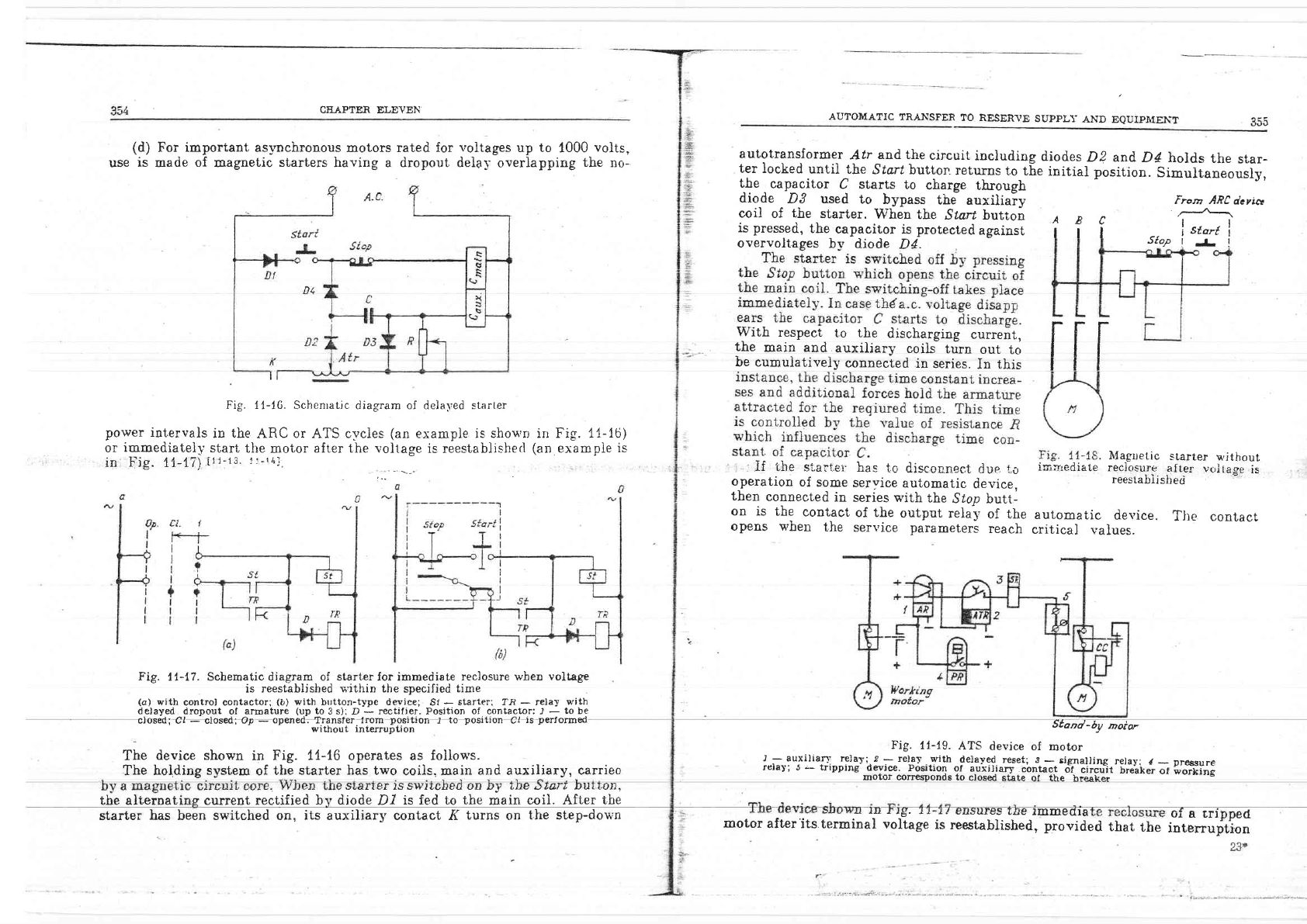
(d)
For
important asynchronous
motors
use
is
made of magnetic
starters
having
a
AUTOMATIC
TRANSFEN
TO
NESERTUE
SUPPLY
AND
EQUIPIUE}iT
is pressed,
the
capacitor
is
protected
against
j
I i -.
I
st"rt
I
Stop
!
J-
i
autotransformer
.4[r
and the
circuit
including
diodes
D2 and,
D4 holds
the
star-
ter locked
untii the
Starl buttor'.
returns
to the
initial position.
Simultan*ouriy,
the
-
capacitor
C starts
to
charge
through
diode
DJ used
to
bypass
the
auxiliaiy
Fram ARt
deyiu
::1i^l^ih'.:tTl:' Il',1 lry-fyT
button
A
I
e -
CEAPTER ELEVEN
rated
for
voltages
up to
1000
volts,
dropout deia-v
overlapping
the
no-
Fig. 11-16.
Schenratic diagram of delal'ed starLer
power
intervals
in the
ARC or ATS c3'cles
(an
example
is shou'n
in
or
immediateiv
start
tlre motor
after the
voltage is
reestablisherl
(an
in
F'ig.
71=17)
[1i-13'
l1-14].
overvoltages
b-v diode
D4.
with
respect
to the
discharging
current,
f !- [
the
main and
auxiliary
coiis
rurn
out
to
I | |
be
cumuiativeiy
connected
in
series.
In this
i i i
Fig. 11-1ti)
example
i-<
Fig.
11-17. Schematic diagra.r.n. of. start.er for immediat,e
reclosure when
voltage
rs reestabljshed v'itliin the specified
time
(a)
with
control contactor:
(b)
with button-type device;
St
-
starter; f,R
-
rela]
n'ith
delayed dropout
of
armature
(up
to
3
s):
D
*
rectifter.
Position
of contactor: J
-
to be
closed;
Cl
-
closed;
Op
-
opened.
T.ransfer.
from
position
J
to
position
Cl
is
performeo
without interruption
If
the
siaitei.
has
to
disconnect
due r,o
irn;ediate
#,ffi!'i
;"r',Tl"l"i;'"-J-"lj
operation
of
some
seryice
automatic
device.
reesi.abiisireri
then
connected
in
series
q'ith
the
Stop
butt-
on
is the
contact
of the
output relay
of the
automatic
device.
The
contact
opens s'hen
the
service parameters
reach
critical
values.
Stand-by
moior
Fig.
1t-19.
ATS
device
of motor
The
device shown
in
The hoiding
system
of
Fig. 11-16 operates as follows.
ttre
starter has
two
coils. main
and
auxiliarv.
carrieo
J.- auxilia:1'
reiay;,t
-
rc)al
.with
deiayed
reset; a
_
signalling
rclay;
J
-
tripping
deviee.
Position of
auxiliary
contact
of
circu-it
motor cofr€sDonds
to closed stste of the hregker
rela)';
4
-
pressure
breaxer
Of workins
f,ne at[ernat
. ..a. I I
eurrent rectrrreo D
r.
I nt
.
a I . .t
' .l
tf. ,l
olooe l)t
ls Ieo Lo
lne
marn
coII. Arler
f,.oe
v9
uug
I
motor
after'its.terminal
voltage
is
reestablished,
mmeora
oI
a rrrpped
provided
that
the
interruotion
40r
!1J-
starter
has been switched on,
its
auxiliary contact .K
turns
on
the step-down
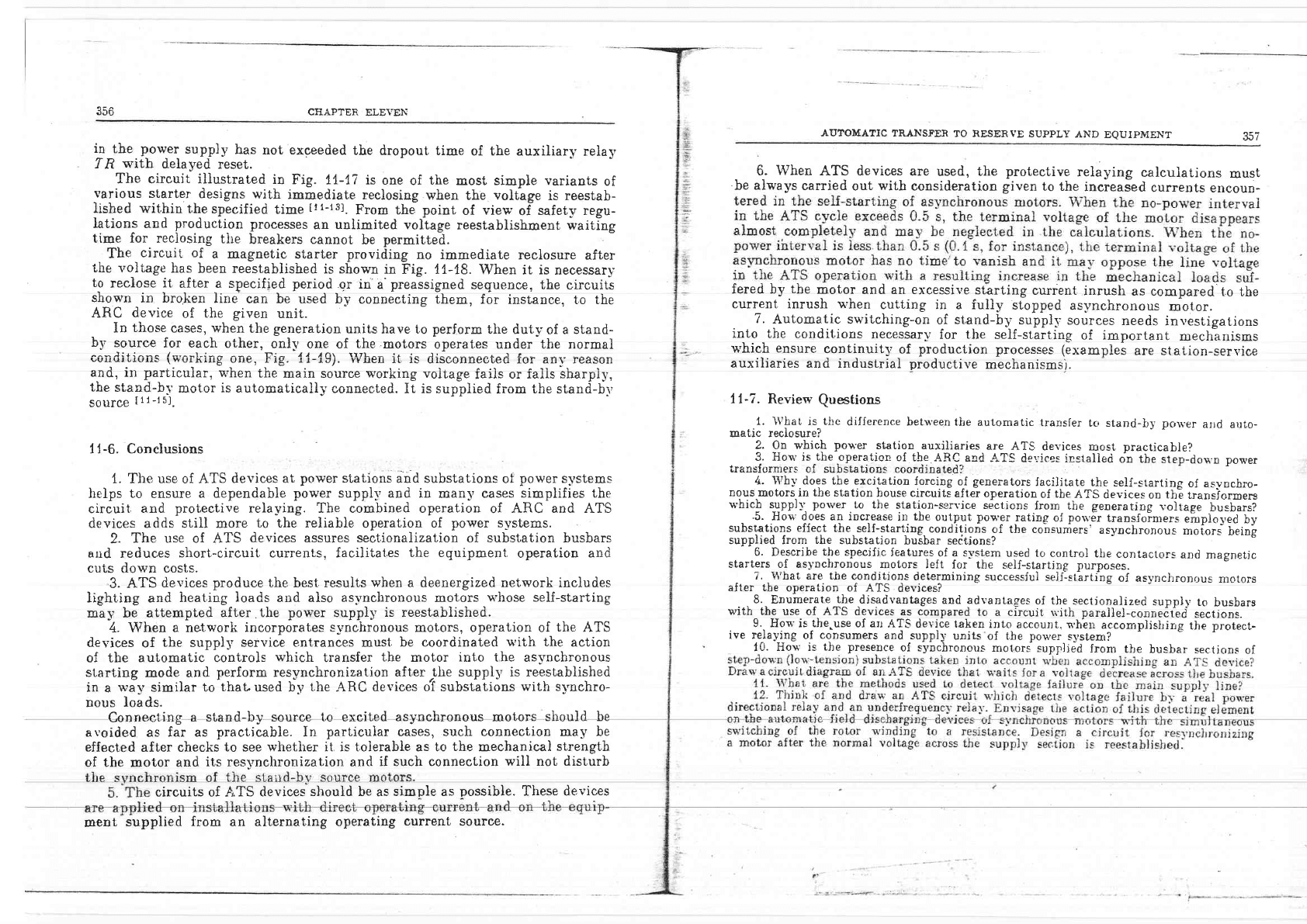
JJO
CIIAPTER
ELEVEN
t3_the
qo\il_ei
supply
has
not exceeded
the dropout
time
of the
auxiliar_v relay
7R
v'ith
dela5'sd
reset.
The eircuit illustrated
in
Fig.
11-{7 is
one
of
the
most simple variants
of
various
slarter
designs
with
immediate
reelosing
when
the
vo]tage
is reestab-
Iished within
the
specified
time
tr1-131.
From the- point
of
view
of
safet5' regu-
Iations and
production
processes
an uniimited
voltage reestablishment
waiting
time for
reclosing
tiie
breakers cannot
be
permitted.
The
circuit of
a magnetic
starter providing
no immediate
reclosure
after
iire voitage
has been reestabiished
is
shown
in
Fig. 1L-18.
When
it is necessar-v
to
reclose
it
after a specifled period
or in
a'preassigned
sequence. the
circuits
shown
in brqken
line'
can be used bv
connecting ihem,
for instance,
to the
ARC
device
of
the
given
unit.
In
those
cases, when
tiie
generation
units
have
fo
perform
the dut-v
of a
stand-
b-r,
source
for each
other,
only one of
the.motors
operates under the normal
-^-J:+.:^'^^ /.-.^-l-:*- ^-^ T]:- t1 1.'\ rrTL-- :r -'- lr-- ,r ?
(;uilur
Liurr.s
\wurHrrrH
rrrre. .r tg.
t
r-rJ).
yv.uet
II ls
olsconneeteo Ior anY rgason
and,
in
particular,
when
t,he
main source
wori<ing
voitage
faiis
or faiis sharpiy,
the
stand-b5'
motor is automaticalli'connected.
It
is supplied
from
the stand-bi'
s0urce
[
1
1-15].
1 1-6. Conelusions
1. Tlie
use
of
ATS devices
at
po\tr'er stations
and substations
of
power
systems
helps to
ensure
a dependable
power suppiv and in
many cases
simplifies the
circuit,
and protective relaying. The combined operation
of
ARC and ATS
devices adds still more
to
the reliabie
operation
of
power svstems.
2.
The use of
ATS
devices assures sectionaiization
of
substation
busbars
and reduces
short-circuit currents, faciiitat,es
the equipment,
operation
and
cuts
dorvn
costs.
3.
ATS
devices
produce
the. best, resuits
when a deenergized network
includes
Iighting and
heating
loads
and also
asvnclironous
motors
u'hose
self-starting
ma*v be
attempted
after.the
power
supply
is
reestablished.
4.
\4/hen
a network incorporates
synchronous
notors, operation of
the
ATS
devices
of
the
supply
service entrances must.
be coordinated
with the
action
of the aulomatic
controls
which
transfer
the
motor
into
the as5'nchronous
starting
mode and
perform
resynchronization
aft,er tire supply is reestablished
in
a
rva-r,' similar
to
thaL
used bv
t,he
ARC
devices of substations
with
s)'nchro-
nous
}oads.
Conneet.ing
a stand-b-v source
to excited asynchronous motors
sliould be
avoided
as
far as
practicable.
In
particular
cases,
such connect,ion may be
effected
after checks
to see
whetirer it is t,oleralile as to
the
mechanical
strength
of the motor and
its resvnchronization and
if such connection
will not disturb
AI]TOMATIC
TR,A.NSFER
TO RESERVE
SUPPLY
AND
EQUIPMENT
6.
When
ATS
devices are
used, the
protective
relaying
calculations
must
be always
carried
out
with
consideration
given
to
the
increased
currents
erlcoun-
fered by
the
motor
and an exces,sive
starting
current
inrush
as
compared
to
the
current inrush u'hen
cutting in a fuliy
stopped
asynchronous
motor.
7.
Automatic switching-on
of
stand-by
supplS
sources
needs
investigations
into
the condit,ions
necessarj*
for the
self-starting
of important
nrechinisms
which ensure
continuitl'
of
production
processe-s
(examples
are station-service
auxiliaries
and industrial
productive
mechanisms).
11-7.
Review
Questions
1. \\rhaf
js
thc
difference
bet'iveen the
automatic
trans{er
to stand-b-y
po\\.er
arrd arrto-
rnatic
reclosure?
2.
On which
po\\'er
station auxiliaries
are ATS
devices
most
Dracticable?
3. How is the
operation
ol tbe
ARC and
ATS
de','iees
instalied
on tbe step-dov,n
power
transfcrmer,.
of substations coorriinated?
4. \4Ih-v
does the
.excitation
forcilg
oJ
generators
faciJitate
the
self-starting
of
asy'ncbro-
nous
motots in
the
station
house circuits
af
ter
operation
of
the
ATS
devices
on
thi
trarrsicrmers
which s31Rf)r'power
to the
station-service
secticns
from the
generating
soltage
lusl";i
.5.
Hou'does an
increase
in
tbe
output
po$'er
rating
oi
po*'er
tran-*foinrers
eiiiploS'ed
by
substations effect
the,self-starting,
conditions
of the consumers'
asynchronous
moi,oti
being
supplied from
the
substation
busbar sections?
6.
De-scribe
the
specific
features
of a system
used to
control
tlre
contactors
and
magnetic
starters of asynchronous
motors left
for the
self-starting
purposes.
,ers
ul .rbluuuJ'ultuus ruLrLOrs
relr
IoI tne
setl-slalllng
purposes.
7, \\'hat are tbe
conditions
d.etermining
successful
self-stlrting
of as_vncirronr_rus
motors
after
the
operation of ATS
devices?
8. Enumerate
the
djsadvantages
and advantages
of the.seclional-ized
suppi
6. .Unumerate
trJe
dlsadvantages
and advantages
of tbe.seclionalized
suppil
to
busbars
with the
use of ATS devices as compared
to
a circuit n'ith
parallel-connedred'sectjons.
9. Hos'is the.use
of alt AT.i
deviie l,aken
into
account. n'hin
accon:rplishirrg
the
nrotect-
wrLIl Lrle
use or.r\rD oevlces as compare0
IO
a clICUtt \l'Itn
parajlel-connected
SeCtjOnS.
.
9., Hos'islhe.use
of alr AT*i
deviie l.aken
into
account. n'h'en
accon'rp)ish!rrg
the
protect-
ive reJaf
ing of
consumers
and
supply
units'of t.he
pon'er
system?
10.
Hox is
the
presence
of synchronous
mol.ors
supr,lied
from tire busbar secrions of
10.
Hox is
the presence
of sy
ts
oI t.ne
po\\'er
s]'steml
us mol.ors
supplied
from
tbe
busbar
sections
of
circuits of ATS devices
sliould
beas
simpie as
possible.
These devices
ment
supplied
from
an alternating
operating
current
source.
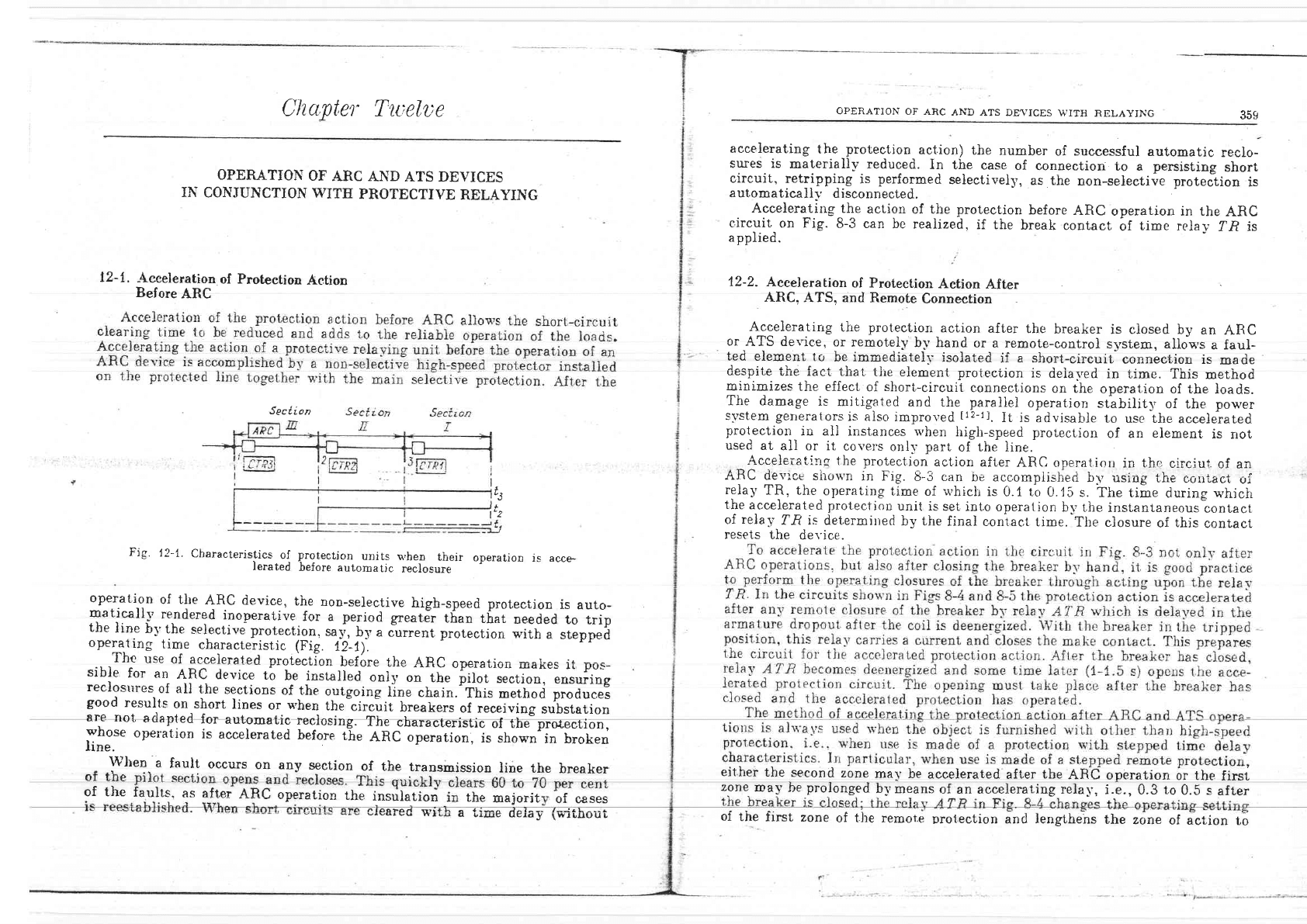
Chapter
Tu;elue
OPERATIO]T
OF
ARC
AND
ATS DEVICES
I}i
CONJUNCTION WITH
PROTECTIVE
RELAYING
I
vz
tf
lz
Fig.
12-1.
Characteristics
of
protectjon
units u,hen
their
operation
is acce-
terated
.belore
automatic
reclosure
OPERATION
OF ARC
AND
ATS DE\/ICES
WITH
RELAYING
35f,
I2-1.
Lceeleration
of Protection
Aetion
Before
ARC
acceierating
the
protection
action)
the
number
of -successful
automatic
reclo-
sures
is
materiail-n*
reduced.
In
the
case
of
conneetion
to a
persistinE
short
circuit,
retripping
is
performed
seiectively,
fls
the
non-selective proteciion
is
aut,omaticalll'
disconnected.
Accelerating
the
action
of the
protection
before
ARC
operation in the
ARC
c.ircuit
on Fig.8-3
can
be realized.
if the
break
contaet
of
ti*e
relav
ZJ?
is
a pplied.
12-2.
A,eeeleration
of
Protection
Aetion
After
ARC.
ATS,
and Remote
Connection
Al,celeratirrg
the protection
action
after
the
breaker
is closed
by
an
ARC
or-ATS
device,
or
remot,ely
b1'hand
or
a remote-control
system,
allon's
a
faul-
forlolo-an*lr.}'^i*-^J;^+^l-'.i^^l^+^J:f^^L^-r.--*--.:r
uvu
vreJJerr!
f
v !E ruuEuto
Ltrr
\
lDulcl
L,utl
11
a
stlur-L-uII'{.iul
L
c(]lll]guLlon
ls
ma oe
l^^-:+^ +L^ f^^r rL^r rl. - ^l---- - -r
oespii,e
ine iact
inal
t.ire eiement
proteciion
is
de]aved
in time.
This
method
minimizes
the
effect
of
sliort.-ci.rcuit
connect,ions
on the
opeiation
of the
ioads.
The
damage
is
mitigated
and
the parallel
operation
sfibilit]'
of
the
power
svstem gerrerator-s
is also
improved
lt2-11.
It is
advisable
to
u-se the
accelerated
protectioti
in all
instances rvhen
irigh-speed
prorection
of an
eiement
is
not
used
at
a}l
or
it
covers
onlv
part
of
the
line.
-Acceleralilg
the protection
act,ion
after
ARC
operaticrr
in
the
circiut.
of an
ARC
device
silc'*'n
in
Fig.
8-3 can
be.
accornplisherl
bv using
the
coniact
oi
relay
TR. the
operating
t.ime
of
rvhich
is
0.1 tb
0.15
s.
The time
durins
u'hjch
the
a_ccelerated
protectiori
unit is
set
inlo
operation
b1,
the
instantaneousi,ontact
of
relay
TR is
det,ermired
by the
finai c.ontact
time.-Tire
closure
of
this
contact
resets
the
device.
operation
of tlre
4RC
device,
the
non-selective
high-speed
protection
ryaticall-v
rendered
inoperative
for a period
great6r
than
that
needed
the
Iine
b1'
the
selective
protection,
sali,
bi,
" "-urr.nt
protection
with
a
opera.ting
time
characrerjstic
(Fig.
[Z_t1'.
is
auto-
to
trip
stepped
Section
The
use
of accelerated
nrot.ce.t.inn hefnro +ho AEIa ^*^-a+i^- *-r-^^.:. -^^
sibie
ror
an
ARC
device-d
il
i;;lr;d
;;i-:""il;""ii#';i:.rT#".",1.',,ftT;
srure
ror
an
Aflu
devlce
to
be installed
oniy
on
the pilot
section,
ensuring
reclosttres
of all
the
sections
of the
outgoing
line
chain.
This
method
produc.es
chain.
This
method
produc.ei
)v
PtvuuL.u-
9::1l:t:llt ?l,short
lines
or.
u'hen
the"circiit
breakers
of
receiving
substation
lf^::t 3!aqlea
for
automatic
reciosing.
Thc
characteristic
of the prodecrion,
wnose
operation
is
accelerated
before
the
ARC
operation,
is shor+,n-in
broken
Iine.
of the
When
a
fault
occurs
on
any
section
of
the
transmission
line
the
breaker
either
the
second
zone
may
be
accelerated
after
the
ARC
operation
or the
first
zone_
rDay
De
prolonged
b1'means
of an accelerating relal',
i.e.,
0.3
to
0.5 s
after
faults.
as after
AF-C
oncratinn lha incrrlo+i^*
-
r
*-
-
rlroutq
urull
+J.^ *^:^-:+
Lrlv
IrraJUr J L
^r ^- ^^-
ur uiusEs
cteS,rec
*'l
AU
e
detay
-i4L ^--t
wlLllt uL
of
the
first
zone
of
t.he
remoi.e
protection
incl lengthens
the
zone
of.
action
tI
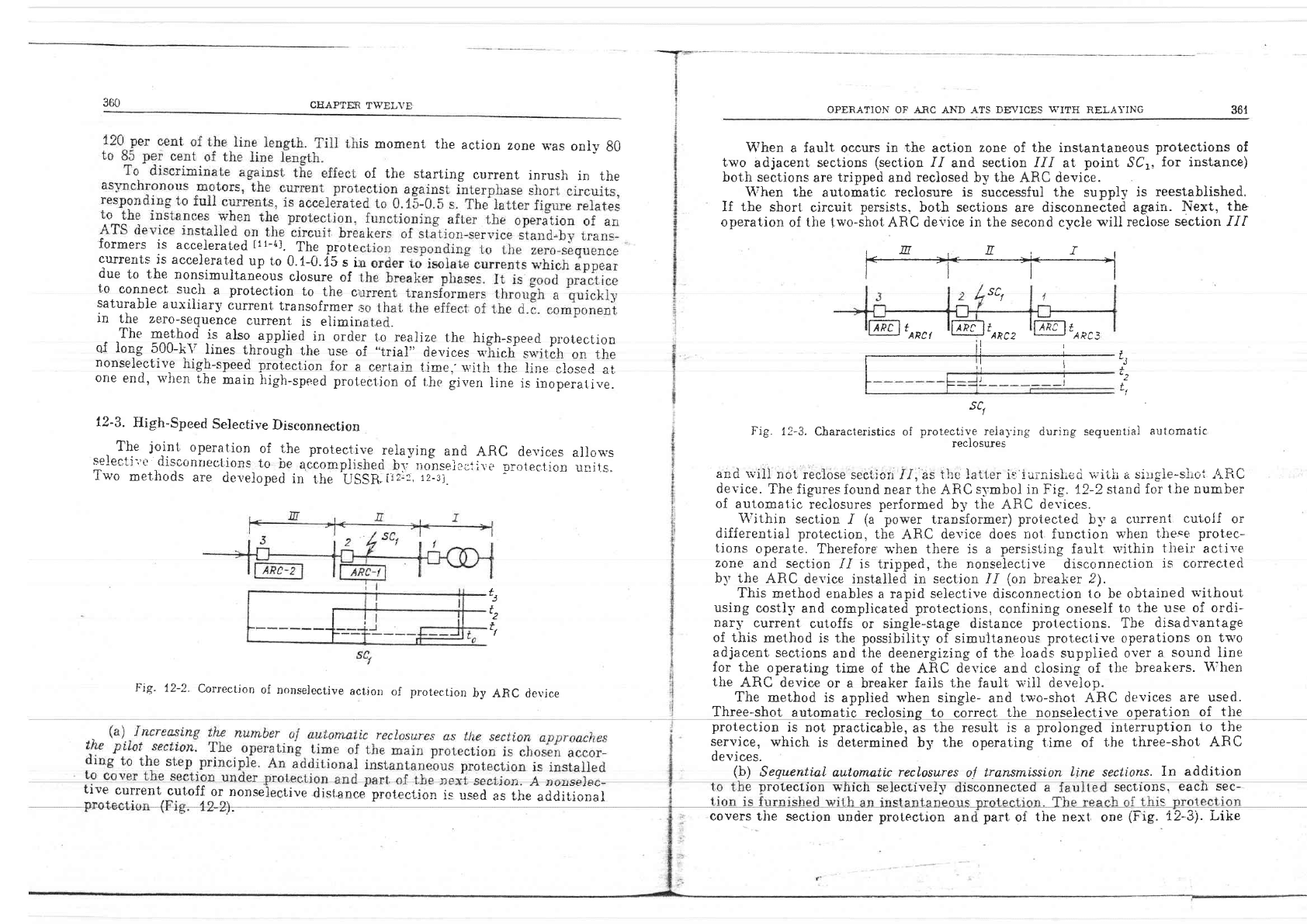
JbU
CIIAPTER
TWEL\IE
is
moment
the
actiori
zone
was
oniy
80
of the
starting
current
inrush
in the
formers
is
accelerslsfl
t1t-{J.
The
prote
currents
is acceierated
up to
0.1-0.fSs
i:
due
to the
nonsimultaneous
closule
of
to
connect
sucir
a
protection
to
the
cr
saturable
auxiliary
iurrent,
tran,qofrmer
r
in
the ze.ro-sequence
current
is eiimir
The method
i:
also
applied
in
order
t,o
reaiize
the
high-speed
plotection
of
long
5-00-\\'
Lines
through
the
u-se
of
"trial"
devices
$,hich
su'itch
on
the
nonselective
high-speed
proi,ection
for
a
certain
time,. u,itli
the
iine
ciosed
at
one
end, wiien
the
mainirigh-speed
prot.ectioo
of
t-he
given
iine
ii-inoDeratiye.
12-3.
High-Speed
Selective
Disconnection
,
T.\.
ioj.nt
operation
of
the
protective
rela_ving
and
ARC
devjces
allows
selectl"'L'
cllsconlreotions
to
be
a.ccompiished
br,
lionselaiii've
Drotec.tior:
units.
Two
methods
are
developed
in
the
'USSR
iiz:g,
ti-sl.
+
a
-2
t
OPERATION
OF A-RC AND -4,TS
DSV'ICES
UIITH
RELA-\"ING
S/hen a fault occurs
in the
action
zone
of
the instantaneous
protections
of
two
adjacent
sections
(sectian
II
and
section III
at
point,SCr.
for instance)
both sections
are
tripped
and
reclosed
by the ARC device.
\4lhen the
automatic reclosure
is
successful
the
suppiy
is
reestablished.
If
the
short
circuit
persists.
both sections
are
disconnected again.
Next,
tbe
operation
of
the
two-shot.
ARC device
in the second
cycle
.n'ill
reclose
section -f.I/
361
IIEIIT
i
sct
t
AKLZ
Wrno*
i^P.l
lt
ti
flRnt
.J
l,QC.l
i._i-i
J
+
L^-2
t
SC,
Fig.
12-3.
Characteristies of
protectiri:.1?rr1,'tn*
during sequential
automatic
and
.*ii}
not'r'bclose
seCtiorr iI,'as
t]:c latt.er ii: iuinis].ieo rcitii a
sirrgie-sLot ARC
device.
The figures
found near
the
ARC
s1-mbol
in Fig. 12-2
stand for
the
number
of
automatic
reclosures
nerformed
bv
tire
ARC
devices.
\4lithin
section
.I
(a
^power
traniformer)
protected
b]'a
curreni
cutolf
or
differential
protection,
the
ARC
device
does not
function
wlien
tirese
protec-
t,ions
operate.
Therefore
r+'iren
there is a
persisting
fault
n'ithin
t,ireir
active
zone
and sect,ion
II is
tripped,
the nonselective disconnection
is
corrected
b1'the
ARC
device instalied in
section
//
(on
breaker
2).
This
method enables
a rapid
selective
disconnection
to be obtained
u'ithout
using
costiy
and
complicated
protections,
confining oneself
to
the
use
of ordi-
nary
current
cutoffs
or
single-stage
distance
protections.
The
disadvantage
of this
method
is the
possibilitv
of simultaneous
protective
operations
on
tq'o
adjacent
sect,ions
and
ihe
deeneigizing
of
the load-s supplied on'"t
a
sound line
for
the
operating
tiroe
of
the
ARC
device and
closing
of
the breakers.
\4rhen
the
ARC
device
or
a breaker
fails
the
fault,
u'iil deveiop.
The
method is
applied
t'hen
single- and
t'q'o-shot
ARC
devices
are used.
Three-shot
automatic reclosing to
correct
the
nonselective
operation
of
tlie
prot.ection
is not
practicable,
as
the
result
is
a
prolonged
interruption
to tjre
sert'ice,
which
i-q determined
by
the
operating
time
of
the
three-shot
ARC
devices.
(b)
Sequential automatic reclosures
o.f
trartsmisston
line
sectians.
In
addition
Fig-
12-2.
correction
of
nonselective
acl.ion
of
protec.tion
by ARC
devjce
e
protectlon
*'nlcn
seec[rvery lsoonnecteo a
sectrons.
eacn sec-
q
tive
current
cut,off
or nonse
t
--
r^r
.r rrvusrL_r\'v
tive
dist.ene.e nrntpe.{inn ic rrqorll oo f},o..1 ,1 ;+i^-^l
gu
vrrv
quurulvlJal
covers the
section
under
protection
an
part
of
the next,
one
(Fig.
i2-Ji. Like
